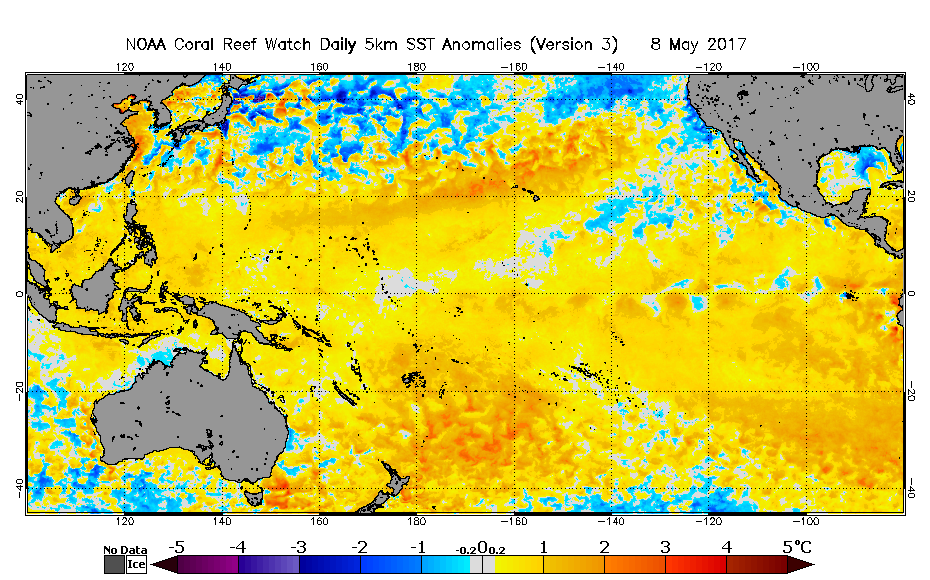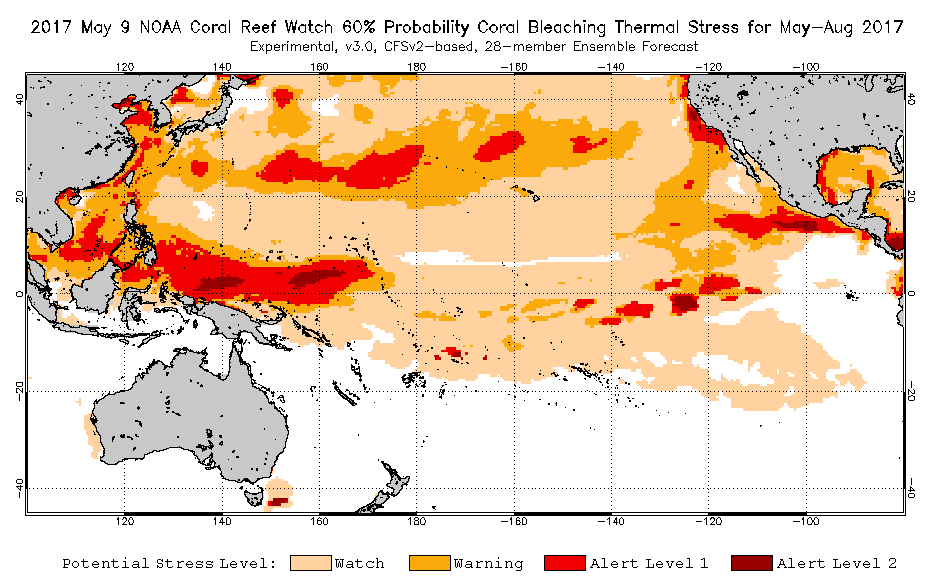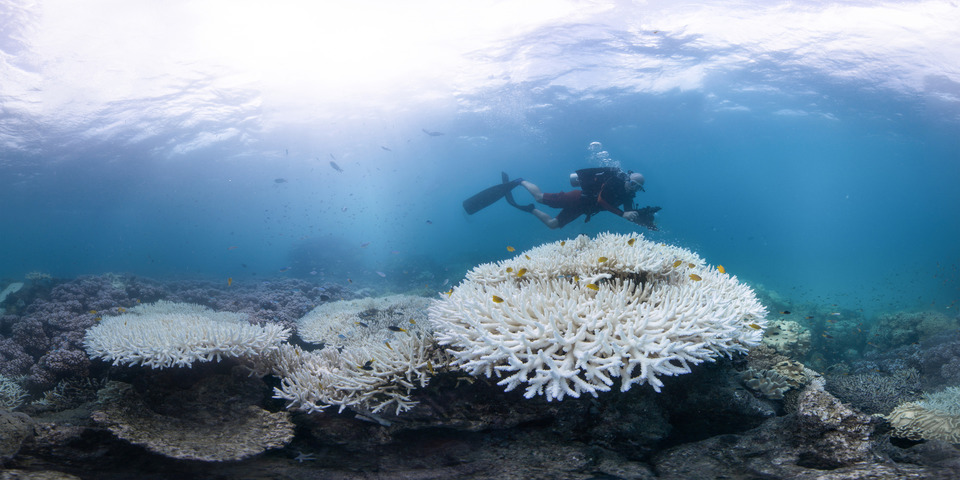Coral Bleaching Heat Stress Analysis and
Seasonal Guidance through August 2017
(Released May 9, 2017)
Current conditions:
NOAA Coral Reef Watch's (CRW) near-real-time satellite monitoring shows above-average sea surface temperatures (SSTs) across much of the southern Pacific Ocean, from Fiji eastward to the Southern Cook Islands (Figure 1). The passing of tropical cyclone Donna around Vanuatu and New Caledonia in early May 2017 didn't suppress warm anomalies much in the region. NOAA's National Centers for Environmental Prediction ENSO Alert System continues in a "Not Active" status. SSTs remain near-average across much of the central equatorial Pacific Ocean and only slightly above-average in the eastern Pacific. E NSO-neutral conditions are expected to persist through at least Northern Hemisphere spring 2017, with increasing chances of a developing El Niño by late summer/early autumn.

|
||
|
Figure 1. NOAA Coral Reef Watch's Satellite Sea Surface Temperature (SST) Anomaly product for the Pacific region. |
||
HotSpots are mostly below the bleaching threshold for most of the Pacific, with the exception of the Samoas and the eastern Pacific along Colombia and Ecuador (Figure 2). The majority of the tropical southern Pacific has decreased to a Bleaching Watch status, with areas of remaining heat stress that can lead to coral bleaching concentrated around American Samoa (Alert Level 2), Wallis and Futuna (Bleaching Warning), and Northern Tonga (Bleaching Warning) (Figure 3). Coral bleaching has been confirmed in American Samoa, but unlike 2015, which mainly affected shallow reef areas, the 2017 bleaching has reached deeper corals. Bleaching also has been reported on the island of Niue. In addition, widespread, severe bleaching was confirmed again on the Great Barrier Reef (GBR) - for the second year in a row. The central GBR has bleached most heavily this year (see photo from the Cairns area of the GBR, Figure 5); however, large sections of the northern GBR, which experienced severe bleaching heat stress in both 2016 and 2017, have been reported dead due to the mass bleaching in 2016.

|
||
|
Figure 2. NOAA Coral Reef Watch's Satellite Coral Bleaching HotSpot product for the Pacific region. |
||

|
||
|
Figure 3. NOAA Coral Reef Watch's Satellite Bleaching Alert Area (7-day maximum) product for the Pacific region. |
||
CRW's most recent Four-Month Coral Bleaching Heat Stress Outlook (Figure 4) projects heat stress in American Samoa to continue until at least the beginning of June 2017. The possibility of Bleaching Alert Level 1 is predicted for the western Pacific Ocean near the Marshall Islands and eastern Federated States of Micronesia in July and August. The beginning of September may see elevated SSTs in the Northwestern Hawaiian Islands, which are predicted to reach Alert Level 1.

|
||
|
Figure 4. NOAA Coral Reef Watch's Four-Month Coral Bleaching Heat Stress Outlook for May-August 2017 for the Pacific region. |
||

|
||
|
Figure 5. Photo of mass coral bleaching near Cairns, Australia in February 2017. Photo Credit: The Ocean Agency. |
||
NOTE: This report focuses on NOAA Coral Reef Watch's Version 3.0 (or v3) 5km satellite-based coral bleaching heat stress products and v3 Four-Month Coral Bleaching Heat Stress Outlook. The 5km satellite products presented here use CRW's new color scales, which are implemented in the images posted on the CRW website.
To monitor the intensity and location of bleaching heat stress in your coral reef region of interest, please follow NOAA Coral Reef Watch's satellite monitoring and outlooks closely in the coming weeks: https://coralreefwatch.noaa.gov/satellite/bleaching5km/index.php and https://coralreefwatch.noaa.gov/satellite/bleachingoutlook_cfs/outlook_cfs.php.
CRW's current satellite and modeled products can be found at:
https://coralreefwatch.noaa.gov/satellite/index.php
CRW's Four-Month Coral Bleaching Heat Stress Outlooks can be found at:
https://coralreefwatch.noaa.gov/satellite/bleachingoutlook_cfs/outlook_cfs.php
CRW's 5km satellite Regional Virtual Stations can be found at:
https://coralreefwatch.noaa.gov/vs/index.php
Sign up for automated bleaching alert emails for CRW's 5km Regional Virtual Stations at:
http://coralreefwatch-satops.noaa.gov/
CRW's 50km satellite Virtual Stations can be found at:
https://coralreefwatch.noaa.gov/satellite/vs.php
Please report bleaching events (or non-events) at:
http://www.reefbase.org/contribute/bleachingreport.aspx
Disclaimer
The content posted on this web page solely represents the opinions of the authors and does not constitute a statement of policy, decision, or position on behalf of NOAA or the US Government.
The appearance of external links on this World Wide Web site does not constitute endorsement by the Department of Commerce/National Oceanic and Atmospheric Administration of external Web sites or the information, products or services contained therein. For other than authorized activities, the Department of Commerce/NOAA does not exercise any editorial control over the information you may find at these locations. These links are provided consistent with the stated purpose of this Department of Commerce/NOAA Web site.